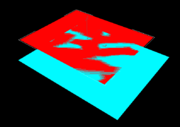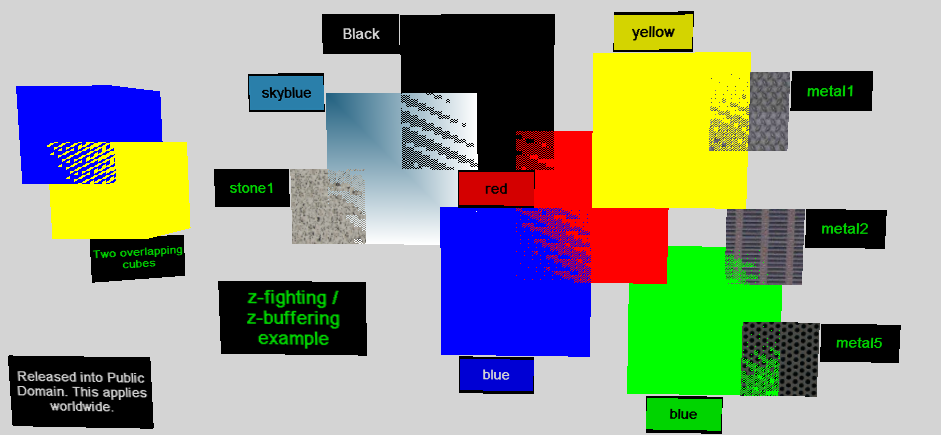
Z-fighting
Encyclopedia

Rendering (computer graphics)
Rendering is the process of generating an image from a model , by means of computer programs. A scene file contains objects in a strictly defined language or data structure; it would contain geometry, viewpoint, texture, lighting, and shading information as a description of the virtual scene...
that occurs when two or more primitives have similar values in the z-buffer. It is particularly prevalent with coplanar polygons, where two faces occupy essentially the same space, with neither in front. Affected pixels are rendered with fragment
Fragment (computer graphics)
In computer graphics, a fragment is the data necessary to generate a single pixel's worth of a drawing primitive in the frame buffer.This data may include, but is not limited to:* raster position* depth...
s from one polygon or the other arbitrarily, in a manner determined by the precision of the z-buffer. It can also vary as the scene or camera is changed, causing one polygon to "win" the z test, then another, and so on. The overall effect is a flickering, noisy rasterization of two polygons which "fight" to color the screen pixels. This problem is usually caused by limited sub-pixel precision and floating point
Floating point
In computing, floating point describes a method of representing real numbers in a way that can support a wide range of values. Numbers are, in general, represented approximately to a fixed number of significant digits and scaled using an exponent. The base for the scaling is normally 2, 10 or 16...
and fixed point
Fixed-point arithmetic
In computing, a fixed-point number representation is a real data type for a number that has a fixed number of digits after the radix point...
round-off error
Round-off error
A round-off error, also called rounding error, is the difference between the calculated approximation of a number and its exact mathematical value. Numerical analysis specifically tries to estimate this error when using approximation equations and/or algorithms, especially when using finitely many...
s.
Z-fighting can be reduced through the use of a higher resolution depth buffer, by z-buffering
Z-buffering
In computer graphics, z-buffering is the management of image depth coordinates in three-dimensional graphics, usually done in hardware, sometimes in software. It is one solution to the visibility problem, which is the problem of deciding which elements of a rendered scene are visible, and which...
in some scenarios, or by simply moving the polygons further apart. Z-fighting which cannot be entirely eliminated in this manner is often resolved by the use of a stencil buffer
Stencil buffer
A stencil buffer is an extra buffer, in addition to the color buffer and depth buffer found on modern computer graphics hardware. The buffer is per pixel, and works on integer values, usually with a depth of one byte per pixel...
, or by applying a post transformation screen space z-buffer offset to one polygon which does not affect the projected shape on screen, but does affect the z-buffer value to eliminate the overlap during pixel interpolation and comparison. Where z-fighting is caused by different transformation paths in hardware for the same geometry (for example in a multi-pass rendering scheme) it can sometimes be resolved by requesting that the hardware uses invariant vertex transformation.
The more z-buffer precision one uses, the less likely it is that z-fighting will be encountered. But for coplanar polygons, the problem is inevitable unless corrective action is taken.
As the distance between near and far clip planes increases and in particular the near plane is selected near the eye, the greater the likelihood exists that you will encounter z-fighting between primitives. With large virtual environments inevitably there is an inherent conflict between the need to resolve visibility in the distance and in the foreground, so for example in a space flight simulator if you draw a distant galaxy to scale, you will not have the precision to resolve visibility on any cockpit geometry in the foreground (although even a numerical representation would present problems prior to z-buffered rendering). To mitigate these problems, z-buffer precision is weighted towards the near clip plane, but this is not the case with all visibility schemes and it is insufficient to eliminate all z-fighting issues.


